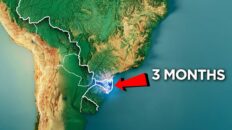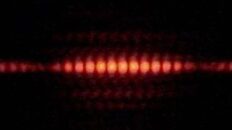Recently, a team of Chinese geologists announced that Earth’s core has “stopped spinning.” This led to a flood of headlines predicting doom and gloom galore. But is it as dangerous as the movie The Core suggests? Let’s look at it.
TRANSCRIPT:
“We know so little of the worlds beneath our feet. Look up on a cloudless night and you might see the light from a star thousands of trillions of miles away. Look down and your sight stops at topsoil. I have rarely felt as far from the human realm as when only ten yards below it.”
– Robert Macfarland, Underland
In the book Underland by Robert Macfarlane, he talks about the world beneath our feet, and the many secrets it holds. He says, “QUOTE”
It is amazing to think about. We can analyze light from stars on the other side of the universe and learn things about its composition, formation, its past and its future over tens of billions of years of space and time. And yet the world just meters below our feet is a relative mystery.
And even further down it’s even more of a mystery, even though the geologic processes taking place down there literally created the land we stand on today.
And at the literal core of it all is the Earth’s inner dynamo, the rotating core that generates convection currents that create the magnetic field that extends out thousands of miles into space and protects us from deadly radiation.
Without it, life on Earth likely couldn’t exist.
So when a team of scientists recently reported that the Earth’s core may have stopped spinning… It generated some alarm.
Are we on the verge of some kind of planetary cataclysm? Or is this just business as usual? …What?
Okay, so before we get into the subject of this video, let’s take a second to address the elephant in the room, which is… the new room.
If you’re new to this channel and just clicked on this because of the topic, by all means, fly past this, here’s the timestamp you want to go to. Move along, nothing to see here.
But if you’re an OG viewer of this channel, (gesture) huh? Whaddaya think?
I don’t want to make too big a deal about it but I’ve had about the same background since 2016. It’s been seven years.
So yeah, time for a change, I hope you like it because I spent some time on it, and if you don’t like it, eh… you’ll get used to it.
I don’t want to go too into detail on the decisions and how this came about because I’ve got a whole video on my second channel where I documented the process, which by the way, isn’t just behind me, I’ve got a whole new desk setup too. Like you can’t see it but this (gesture) is all brand new to me. Go watch that video if you want to see what I’m talking about. Link here.
But yeah, seven years is a long time to do the same old thing. You might see some changes around here beyond just the background. Nothing too crazy, I’ll still be releasing videos every week, but I’m going to be pivoting toward bigger projects, videos where I travel a bit, try new things, also full-on short films and stuff. I’m just wrapping up a short film I shot at the end of last year, here’s a little tease–
So that’s a lot of fun. Lots of cool stuff on the way, new show formats, this is kind-of a whole new era for the channel. I’m excited about it.
To that end, there’s kind-of a big announcement at the end of this video, too much to get into right now, but if you just hold on after the sponsor read, I’ll tell you what’s going on. It’s pretty cool.
But anyway, hope you like the new look, thanks for your patience the last couple of months while I got this worked out, let’s move on to the cataclysm and destruction that awaits us all.
DOOOOOOOOMED!
Earlier this year, a pair of professors at Peking University published a paper that profoundly peaked the popular interest of people planet-wide.
Is this the new direction of the channel? Alliteration? Cool.
They basically announced that they have found evidence that the Earth’s core has stopped spinning. Which sounds like the plot of a bad disaster movie.
Specifically the 2003 movie The Core. That’s exactly what happened, the core stopped spinning. And then Hilary Swank and Aaron Eckhardt had to drill down to the center of the Earth to set off a nuclear bomb.
Because movie.
Extreme weather events, magnetic storms, massive earthquakes, animals acting crazy… these are just some of the events that the movie depicts as resulting from the core stopping.
By the way, I watched this movie, just for this video. You’re welcome.
Movie logic aside, it does beg the question, what exactly would happen to the Earth if the core stopped spinning. And according to this paper… you’re looking at it.
They suggest the core “stopped spinning” in 2009. And has done it many times in the past.
https://acortar.link/XxIVUp — original paper…pretty dense, so I’m mostly using the Nature reporting to make sense of the jargon
So clearly it’s not as dire as in the movie. But it’s not nothing. So what does this actually mean?
A Tale of Two Cores
To understand why we haven’t snuffed out just yet, let’s talk about our planet’s makeup. Like the fact the core is not all one gooey mess.
There’s a liquid outer core. And by liquid I mean molten. As in molten metal, mostly iron and nickel, and it maintains a temperature of about 5000° Celsius (9032° Fahrenheit). Give or take a few hundred degrees.
The outer core lies 2900 kilometers below Earth’s surface, and has a diameter of nearly 7000 kilometers. Roughly the size of Mars.
Elon Musk lands on Mars and realizes Mars was inside us all along…
But think about that for a minute. If you travelled straight through the Earth, you’d be inside the core for most of the trip. It’s kinda like driving out of Texas.
On this theoretical trip, once you reached the outer core, you’d be swimming in liquid metal for about 2200 kilometers. At a total depth of 5100 kilometers, you’d hit the inner core. And you would hit the inner core because unlike the outer core, it’s solid. Though still mostly iron and nickel.
“The animal’s singing with a lot of the same features of a typical blue whale song. Blue whales, fin whales and humpback whales: all these whales can hear this guy, they’re not deaf.
Layered Composition
But how do we know this? It’s not like you can take a picture of the inside of the Earth… Except you kinda can. With sound.
Yes, the same way a bat navigates through a cave, the same way an ultrasound can make a picture of your unborn bebeh, sound waves travel through the Earth, and depending on how they bend and flex and bounce off things, we get a picture of what’s going on underneath.
Luckily for seismologists – and unlucky for the rest of us – earthquakes happen all the time, and we can use those vibrations going through the Earth to get an idea of what’s going on down there. And we’ve been doing this for a long time.
And around the turn of the century, there was a bit of a mystery in seismologist circles because something seemed to cast a “shadow” on their readings.
Specifically, there’s a type of wave called a P-wave, that can be detected across the planet when an earthquake strikes, but it would only be detected at angles up to 104 degrees from the epicenter.
It would then pop up again at angles equal-to-or-greater-than 140 degrees. Creating a 36 degree shadow.
In 1914, a German-American seismologist named Beno Gutenberg figured out the shadow was due to a liquid metal core. But that didn’t completely solve the mystery.
Thing is, P-waves aren’t completely absent from the shadow. Seismologists were still detecting distorted P-waves in the shadow region.
The mystery was finally solved by a Danish seismologist named Inge Lehmann who hypothesized that it might be due to the waves being deflected by a solid inner core.
She checked her predictions against the seismic measurements and found they lined up. So, the solid core hypothesis became accepted, especially later on when it was confirmed by computer models.
By the way, she lived long enough to actually see this ultimate validation, she died in 1993, at 104 years old.
Magnetosphere Maintenance
Above the crust are oceans, trees, people, and about 480 kilometers of atmosphere. An atmosphere held in place by a magnetosphere. You see where I’m going with this.
That magnetosphere is created by convection in the core. Not by the spinning of the solid inner core itself, that’s a misconception, it’s actually the turbulent flow of liquid metal in the outer core.
So yeah, if the outer core ever stopped churning, that would be bad. The magnetosphere would fade. Compasses would quit working, migratory animals would get lost, and… Oh yeah, we’d lose our atmosphere. Small problem.
We’re pretty sure that’s what happened on Mars. It had a magnetosphere and an atmosphere. As soon as it lost the former, the latter wasn’t far behind.
The Rotation Cycle
So the whole “stopped inner core” thing is kind of a mis-labeling in a way?
We’ve known for a long time that the core can rotate at a different rate than the rest of the planet. In fact, in In 1996, it was discovered that the core was actually spinning faster than the rest of the planet.
By the way, the guy who made that discovery was Xiodong Song, the same guy who co-authored this recent paper.
This is called super-rotation and it was estimated that the core was spinning at a rotation rate of one degree per year faster for the core, compared to the mantle and crust.
Later studies confirmed the super-rotation but the speed ranged from 2/10ths of a degree to three degrees faster per year. So, we know that it changes, that it’s variable.
And some studies showed a slower rotation in the past, specifically between 1969 and 1971. The authors of that study actually looked at seismic waves triggered by nuclear tests in that period.
This is of course called subrotation, when the core rotates slower than the mantle and crust.
So the thinking now is the inner core subrotated until sometime after 1971, when it sped up again.
And then, sometime after 1996, the rotation rate slowed down again, eventually bottoming out in 2009, according to Yang and Song.
Ever since then, the inner core has been spinning at the same rate as the outer core, mantle, and crust.
So when I say the core “stopped spinning,” that’s what the air quotes were about, it’s not like it stopped in its tracks, it just got in sync.
Yang and Song suggest the variation is part of a cycle that repeats about once every seventy years. If they’re right, the cycle is similar to a number of other geophysical cycles.
Patience Needed
Seismic data takes time to accumulate. We can’t make earthquakes happen at will, and nuclear testing stopped being cool years ago.
Gah, we can’t do ANYTHING fun anymore.
Point is, we’ve still got a lot to learn, but one thing we do know is that this (point to action scene from The Core) isn’t going to happen. We know this because all of this has happened before.
The slow rotation of the inner core, the weakening of Earth’s magnetic field, and the variation in length of day, this is all just part and parcel of Earth being Earth.
It’s a dynamic planet, and that’s a good thing, that stirs things up and made life happen. It made us happen.
The only thing that is somewhat concerning is the idea that the Earth’s magnetic field could flip, and that has happened before, hundreds of times over millions of years.
And with this weakening of the magnetic field we’re seeing and variations in the core spin, the likelihood of it happening again… Well let’s just say it’s a non-zero chance.
But there’s a couple of things to attach to that, first of all, when the field flips, it doesn’t happen overnight, it could take anywhere from 100 years to 20,000 years, so we’d have plenty of time to adjust.
Now it is possible that during that transition period – long as it may be – the field could be weakened to the point that radiation and cosmic rays could pose more of a threat than they currently do.
But it’s not thought that it would be like an extinction level event, like I said, it’s happened hundreds of times in the past and we don’t have a lot of evidence of extinctions and disruptions in life during those times.
You will need a new compass though.
So, once again, like almost every clickbaity science story, what makes a good headline does not necessarily reflect reality. You gotta dig deeper.
Sometimes you gotta dig all the way to the center of the Earth with a nuclear weapon. Because movie.




Add comment